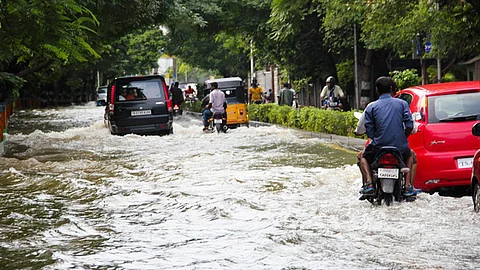
- Topics
- Feature
- Opportunities & Events
- Data
- Hindi Portal
- Topics
- Feature
- Opportunities & Events
- Data
- Hindi Portal

It has been reported that extreme rainfall events are increasing over India and widespread floods have increased threefold over the last several decades from an average of two events per year to six events per year. But the link between extreme rainfall events and rising incidence of floods remains tenuous.
There is scientific evidence that global warming is leading to more moisture loading in the atmosphere, which, in turn, is causing more extreme precipitation events. However, there is no clear evidence that this is leading to an increase in floods.
A new study by Australian and American researchers reported in journal Water Resources Research has confirmed that increased extreme rainfall events do not necessarily lead to increased floods. Many hydraulic factors such as physiography, drainage, catchment size and vegetation cover are critical for peak flood conditions. There are also several unexpected factors that affect flood response to extreme precipitation.
For example, in the US, extreme rain events led to extreme river discharge only 36 percent of the time on an average. Most of it depended on how wet or dry the river catchment area was before the extreme rainfall. If the catchment area was wet prior to the extreme rainfall event, extreme discharge occurred much more frequently than the average, at 62 percent of the time. The percentage dropped sharply to a mere 13 percent if the catchment was dry. Clearly, soil moisture heavily influences flood response to extreme rainfall.
The size of the thunderstorms is another factor. The storms are found to become smaller in size when temperatures are warmer since the convection intensity increases with temperature. In addition, warmer temperatures prolong droughts and dry up the soils and this affects the flood response following extreme rainfall events. Other non-obvious factors include the water storage capacity of tree canopy and leaf wettability of the trees. Leaf wettability was found to increase with temperature for many tree species.
There has been some increase in flooding relating to earlier snowmelt, which shifts the timing of the floods to spring. Likewise, late winter storms with warmer temperatures or rain on snow are found to cause late winter floods in parts of Europe. The timing and magnitude of floods are altered in these cases. Many of the coastal floods are also unrelated to extreme rainfall.
One of the most important factors for extreme rainfall is the rate at which atmospheric moisture is increasing with global warming. As per the Clausius-Clapeyron equation, the capacity of air to hold moisture increases by seven percent for each degree of warming. The increase in extreme rainfall is due to a combination of this increase in moisture as well as changes in atmospheric circulation.
Projecting extreme rainfall is a challenge for climate models. All evidence points to greater than seven percent increase in extreme events, even though specific conclusions vary depending on how the term “extreme events” is defined.
It is often assumed that the temperature-extreme rainfall relationship also applies to precipitation-streamflow link. However, it’s not just the rainfall intensity that matters for streamflows but also the duration and spread of storms. This is in addition to prior wetness and other hydraulic factors.
Historic data shows a decreasing trend in streamflow. The presence or absence of dams or forest covers does not appear to matter. But increasing trends in annual maximum streamflow are seen over smaller catchment areas. Data also shows that small increase in precipitation with warming is much higher than relative increase in streamflow.
Specifically for India, the impact of extreme rain on rivers and streamflow is complicated by dams, reservoirs, urbanisation and other land use changes as well as increased evaporative losses due to global warming. Seven rivers that serve hydropower production are reported to have experienced a decrease in rainfall and streamflow, while climate projections indicate a wetter monsoon in a warmer world and a potential increase in hydropower production. The caveat is that climate models may not fully capture past monsoon trends and may be unreliable for future projections.
This should be placed in the context of the fact that Himalayan-born rivers in India carry some of the highest sediment loads in the world. Sediment loads have a nonlinear relation with streamflow which means these loads can increase more rapidly beyond a certain threshold of streamflow. In addition, extreme precipitation events have increased over parts of the Himalayas and more of the precipitation may arrive as rain instead of snow in a warming world. This would again change the seasonality of peak streamflows.
These multitudes of natural-human system interactions over India point to the urgent need for a better understanding of the complexity of the relationship between extreme precipitation, streamflows and floods, especially where human action may escalate flood risks. (India Science Wire)
(The writer is a professor of Atmospheric and Oceanic Science and Earth System Science at the University of Maryland. He is currently a visiting professor at IIT Bombay.)